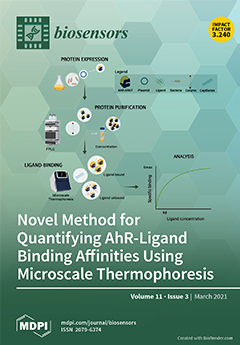A simple and rapid distance paper-based analytical device (dPAD) for the detection of lead (Pb) in foods is proposed herein. The assay principle is based on competitive binding between carminic acid (CA) and polyethyleneimine (PEI) to Pb in a food sample. The paper channels were pre-immobilized with PEI, before reacting with a mixture of the sample and CA. Pb can strongly bind to the CA; hence, the length of the red color deposition on the flow channel decreased as a lower amount of free CA bound to PEI. The dPAD exhibited good linear correlation, with ranges of 5–100 µg·mL
−1 (
R2 = 0.974) of Pb. Although, the limit of detection (LOD) of this platform was rather high, at 12.3 µg·mL
−1, a series of standard additions (8.0, 9.0, and 10.0 µg·mL
−1) can be used to interpret the cutoff of Pb concentrations at higher or lower than 2 µg·mL
−1. The presence of common metal ions such as calcium, magnesium, nickel, and zinc did not interfere with the color distance readout. The validity of the developed dPAD was demonstrated by its applicability to screen the contamination of Pb in century egg samples. The results obtained from the dPAD are in accordance with the concentration measured by atomic absorption spectroscopy (AAS) (
n = 9). In conclusion, this proposed dPAD, combined with the standard addition method, could be applied for screening Pb contamination in food matrices. This platform is, therefore, potentially applicable for field measurements of Pb in developing countries, because it is cheap and rapid, and it requires no significant laborious instruments.
Full article






